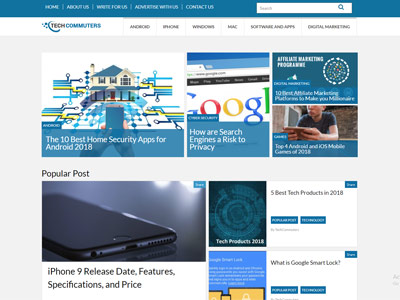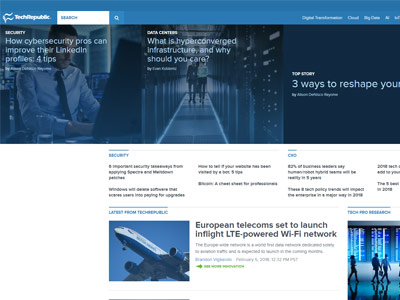The Advancement of the Best tech blog: A Trip With Tech History and Future Trends
The Advancement of the Best tech blog: A Trip With Tech History and Future Trends
Blog Article
Recognizing the Rise of Side Computer in Today's Digital Globe
In the rapidly developing landscape of modern technology, edge computing emerges as a crucial pressure, improving exactly how information is refined and utilized. By transitioning data monitoring closer to the source, side computing addresses essential latency concerns while enhancing data transfer use and enhancing safety and security measures.
What Is Side Computer
Edge computing, although a reasonably recent innovation in the world of modern technology, fundamentally transforms exactly how data is refined and managed by bringing calculation and data storage space closer to the location where it is required. Unlike traditional cloud computer models, which typically depend on centralized data facilities that can be geographically distant, side computing decentralizes information handling. This closeness lowers latency, enhances real-time information processing, and boosts the overall individual experience by ensuring faster action times.
At its core, edge computing involves a network of local tools and framework, such as routers, sensors, and entrances, efficient in processing information at or near the resource. This local handling capability is specifically crucial for applications requiring instant information analysis, such as self-governing cars, commercial automation, and wise cities. Additionally, by unloading data processing tasks from central web servers, side computing reduces data transfer demands and boosts data personal privacy and security, as sensitive information can remain on-site rather than passing through considerable networks.

Secret Motorists of Adoption
A number of aspects are pushing the adoption of edge computer in today's electronic landscape. One of the primary drivers is the exponential boost in linked gadgets, often described as the Net of Points (IoT) This surge develops substantial quantities of data that require to be processed swiftly and efficiently. Edge calculating addresses this requirement by allowing data handling closer to the information source, lowering latency and boosting real-time decision-making capacities.
An additional considerable driver is the need for boosted data transfer efficiency. Centralized cloud systems can become overwhelmed with the sheer volume of information created by IoT gadgets, leading to traffic jams (Best tech blog). By processing data at the edge, organizations can ease network congestion and boost overall system performance
In addition, protection and personal privacy worries are pressing organizations toward side computing. By refining sensitive information in your area, business can reduce dangers connected with information transmission and exposure to prospective cyber dangers.
The rise of applications requiring real-time processing, such as self-governing vehicles and enhanced reality, additionally necessitates the rapid action times that edge computing offers. Jointly, these chauffeurs are making edge computing an indispensable component of modern-day IT facilities, leading the way for its widespread fostering across various markets.
Benefits Over Cloud Computing
How does edge computer distinguish itself from conventional cloud computer? Mostly, edge computing brings information handling closer to the resource of information generation, frequently on regional devices or nearby web servers, instead of depending on centralized information centers. This distance substantially reduces latency, making it possible for real-time information handling and decision-making. For sectors where milliseconds matter, such as independent vehicles or commercial automation, the decreased latency given by edge computer can be important.
Additionally, edge computer improves data transfer effectiveness (Best tech blog). By refining information in your area, just the required information is transferred to the cloud for additional analysis or storage, minimizing the quantity of data that goes across the network. This not only reduces network congestion but likewise lowers data transmission expenses
Side computing additionally uses better data personal privacy and safety. Delicate information can be refined locally without being sent out to the cloud, decreasing the direct exposure to possible cyber hazards. This is especially valuable for industries taking care of secret information, such as healthcare and economic solutions.
In addition, side computing makes certain greater durability and reliability. Local processing permits proceeded procedure even when connectivity to the cloud is endangered, maintaining necessary functions and services regardless of potential network interruptions. These advantages collectively demonstrate edge computing's transformative possibility in maximizing performance and safety in electronic ecological communities.
Difficulties and Factors To Consider
While side computing uses numerous advantages, it likewise offers special difficulties and considerations that must be dealt with to completely understand its possibility. In addition, handling and keeping an eye on a decentralized network of edge devices can be complicated, requiring advanced tools and approaches to make certain smooth operation and upkeep. Best tech blog.
Another consideration is the scalability of side computer options. As the variety of connected gadgets grows, so does the need for refining power at the edge, which can lead to resource restraints. Organizations must very carefully plan their infrastructure to their explanation accommodate this development home without endangering performance or performance.
Interoperability is an additional vital factor. With numerous equipment and software application components included, ensuring compatibility and smooth assimilation can be difficult. Standardization efforts are important to help with interaction in between disparate systems.
Future Fads in Edge Computing
Expecting the future, edge computing is positioned to change different sectors by making it possible for much faster data processing and minimizing latency. As the quantity of data produced by IoT devices remains to expand, side computer will become progressively important in handling this influx efficiently. One considerable fad is the integration of expert system at the side, permitting real-time analytics and decision-making without relying upon cloud-based sources. This change is expected to improve applications in self-governing cars, smart cities, and medical care, where immediate information handling is crucial.
Another arising trend is the growth of edge-native applications created specifically to utilize the special capacities of side computing. These applications will enhance performance and resource use, resulting in raised efficiency throughout different industries. In addition, advancements in 5G technology will even more bolster side computing by giving the essential facilities for high-speed, low-latency interaction between gadgets and edge nodes.
Conclusion
Side computing's rise is driven by the proliferation of IoT devices and the requirement for real-time data handling, which improves performance by decreasing latency and decentralizing data administration. This approach mitigates data transfer inadequacies and security concerns, promoting Going Here advancements in applications like smart cities and independent automobiles. Regardless of challenges such as framework complexity and combination, the future of side computer assures an extra responsive electronic environment, with proceeded technologies shaping its development and expanding its applicability across sectors.
Edge computer, although a relatively current advancement in the realm of innovation, essentially transforms exactly how data is refined and handled by bringing calculation and data storage closer to the location where it is needed. Unlike standard cloud computer designs, which commonly count on centralized data facilities that can be geographically remote, side computing decentralizes information handling. In addition, by offloading data processing jobs from central servers, edge computer reduces data transfer needs and enhances information personal privacy and safety, as sensitive details can continue to be on-site rather than passing through considerable networks.

Report this page